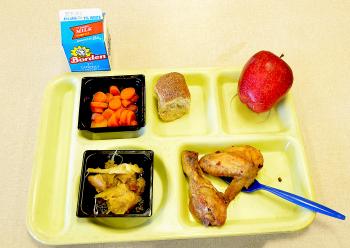
From left, Berwick Junior High School students Bailey Thibodaux, sixth grade, Claire Bergeron, seventh grade and Kimberly Babin, eighth grade, discussed school lunches while in the school’s cafeteria Wednesday.
(The Daily Review/Courtney Darce)

This sample junior high school lunch contains roughly 560 calories. The calorie content of the meal is broken down as: 2 ounces of baked chicken, 200 calories; ½ cup of steamed cabbage, 25 calories; ¼ cup of cooked carrots, 82 calories; fresh apple, 65 calories; 8 ounces of milk, 102 calories; and a 2 ounce whole wheat roll, 85 calories. Because portion sizes are estimates, so is calorie content, according to Mary Grimm-Howard, school food service supervisor for St. Mary Parish.
(The Daily Review/Courtney Darce)
School lunch guidelines changed
While the Agriculture Department is allowing schools to serve larger portions of lean meat and whole grains in school lunches, the government hasn’t increased the number of calories students are allowed.
The elimination of the limits on meats and grains “does give St. Mary Parish Child Nutrition Program the opportunity to consider serving increased portions of meats and grains,” Mary Grimm-Howard, school food service supervisor for St. Mary Parish, said.
Guidelines restricting portion size originally were intended to combat childhood obesity, but many parents complained their kids weren’t getting enough to eat. School administrators say that rules establishing maximums on grains and meats are too limiting and make it difficult to plan daily meals.
The department eliminated limits on meats and grains on a temporary basis more than a year ago. Officials made the rule change permanent last week.
Grimm-Howard said the greater challenge is that meals must remain within the calories required for each grade grouping.
“When more is served, calories are increased and the guidelines for the amount of calories students are to receive have not changed,” Grimm-Howard said.
St. Mary Parish cafeterias already plan meals using the maximum calories allowed. Those ranges are:
—Pre-kindergarten through fifth grade, 550 to 650 calories.
—Sixth through eighth grades, 600 to 700 calories.
—Ninth through 12th grades, 750 to 850 calories.
Claire Bergeron, a seventh-grader at Berwick Junior High, said the meals are tasty but not really filling.
“Some of it fills me up, but it’s not a lot of food, like a lot of portions,” Bergeron said.
The calorie guidelines are part of the Healthy Hunger-Free Kids Act of 2010 enacted, in part, to combat childhood obesity.
Bailey Thibodeaux, a sixth-grader at Berwick Junior High, agreed that the portions need to be larger “because when I go home, I’m not always filled up.”
While Grimm-Howard said she does think the calorie content is adequate, she said it would be good to be able to serve more starches in that number. Currently, they are only allowed to serve a half cup of starches (French fries, mashed potatoes, etc.) per week.
“In most cases we try to serve at maximums because that does increase the satisfaction for students,” Grimm-Howard said.
She said parents should be asking the government for more starches “to stick to the children’s bones” and to increase meal satisfaction for them.
Kimberly Babin, an eighth-grader at Berwick Junior High, said, “I’m happy with the way that they taste because I’ve been to other schools and these lunches are 50 times better than the other schools are. I have no complaints about that,” Babin said.
The students noted that the only drink choice is milk. Students must pay extra for water with their meal and there are no other options, they said.
The other change they said they would like to see is variety in the meals.
- Log in to post comments
